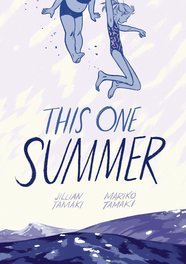"But this summer is different."
 The graphic novel This One Summer by cousins Jillian and Mariko Tamaki is one of those books that really requires a teen sensibility to fully appreciate. Adults can certainly read it (and enjoy it) but I think if you are a 12 or 14 year old (girl especially) then This One Summer would have special appeal.
The graphic novel This One Summer by cousins Jillian and Mariko Tamaki is one of those books that really requires a teen sensibility to fully appreciate. Adults can certainly read it (and enjoy it) but I think if you are a 12 or 14 year old (girl especially) then This One Summer would have special appeal.
The set-up echoes the plots of many other summer novels from the past: Rose and her parents arrive at their cabin in Awago Beach for their annual vacation. Windy and her mother and grandmother are nearby, just as they are every year. Rose and Windy are set for some familiar hijinks: hanging out at the beach, bonfires and picnics, bike rides and, this year, renting some classic horror movies from the local store and getting the crap scared out of them them while their parents are none-the-wiser.
There are some serious undercurrents however--Rose's parents are in a troubled marriage and the source of their conflict, which plays out in dozens of little tense-filled moments throughout the book, is an ongoing object of concern for Rose. Also, she develops a small crush on the high school boy who works at the store and his turbulent relationship with a local girl becomes something she and Windy study with great interest. How couples work, or don't work--the whole concept of romantic love--is the mystery that unfolds for Rose as the summer continues. Windy is a little younger and for her it is mostly a game to watch but for Rose, there is a wistfulness that anyone who survived middle school will recognize. She pines for something that she is not yet old enough to understand. (This is pretty much everything you need to know about middle school.)
This One Summer isn't a sweet story though. The girls are pretty typical girls. They sling a few bad words around, testing them out for effect, and they are all about noticing the older teens, what they have, what they do, how they interact. The girls listen for everything and gather information on sex and flirting, pondering it like miniature Jane Goodalls in the wild. This is where reviewers really and truly must channel their inner teen to appreciate the book and understand how important and common these interactions are and how brilliantly the author and illustrator nail the essence of teenage girl.
[Momentary aside--I can still tell you the names of the first girl and boy in my 6th grade class to make out. I can't tell you much else I learned that year but Gary & Leighann, those two, (and the drama their kissing brought to a hundred lunchtime conversations when I was 12), I will never forget.]
I will be very surprised if This One Summer is not challenged at some point. There are parents who will not be happy to see the language or the sexual suggestions that Rose & Windy spy on. And I'm also sure there are reviewers who will say that not enough happens in this story or that the events are too melodramatic. For me though, it all rang as spectacularly authentic. Teenagers sit around and talk about each A LOT. They flirt, they fall in and out of relationships and sometimes things move far too quickly. Younger teens study the big kids, they follow, they stare, they spend hours talking about what they see. Not a lot happens in This One Summer but it is about as true to real life for most kids that you could hope to find.
That's why it's going to get challenged, and also, why so many teenagers, (again, girls especially), are going to read it again and again.




